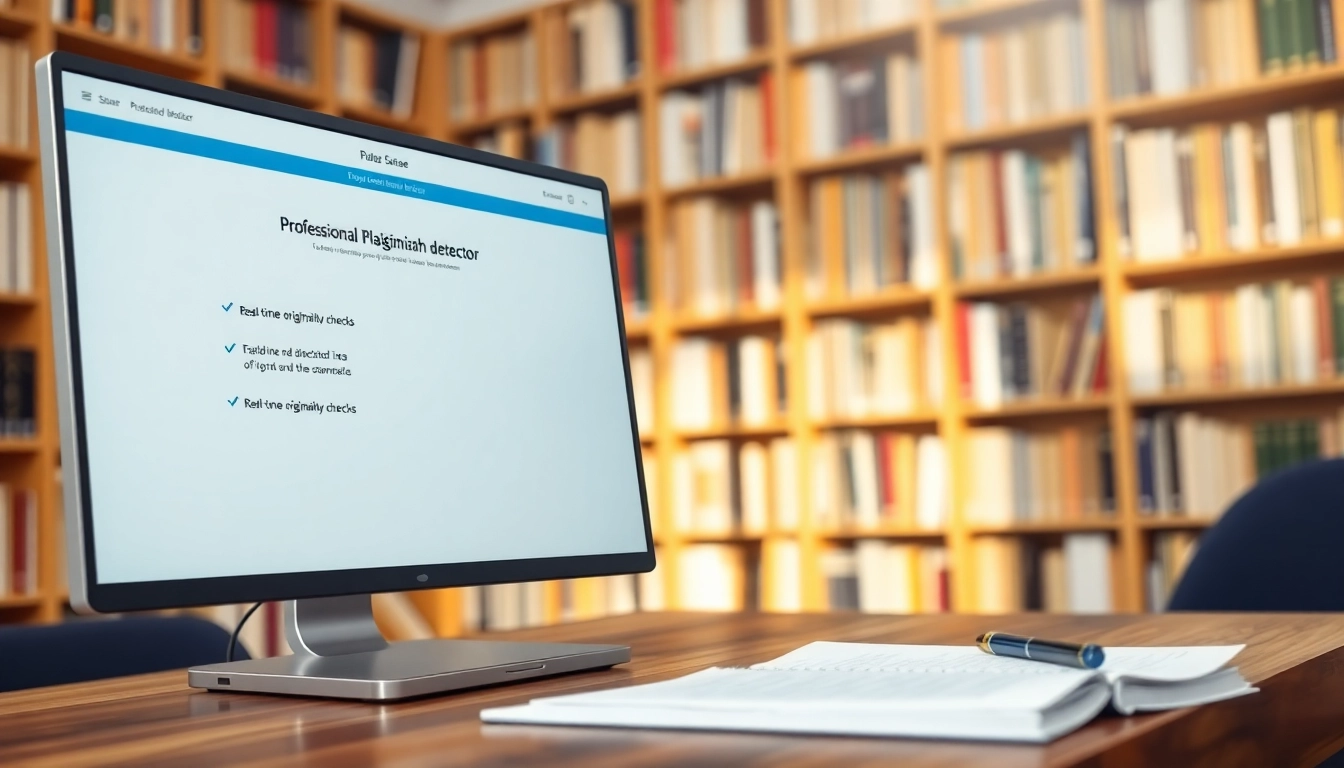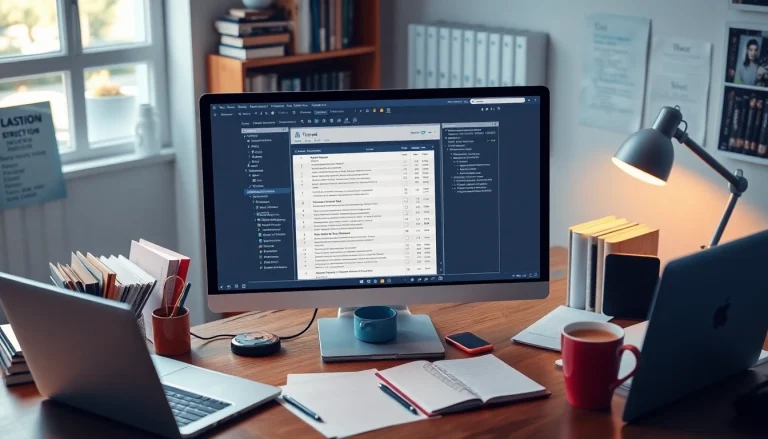Understanding Plagiarism Detection
What is a Plagiarism Detector?
A plagiarism detector is a vital tool that scans text documents for similarities and potential copied content from various sources across the internet. It identifies instances where content appears to be unoriginal or improperly cited, thus promoting academic integrity and originality in written works. These tools are widely used by students, educators, and professionals alike to ensure that their work meets ethical standards. With the rise of digital content creation, the demand for efficient and reliable plagiarism detectors has surged.
How Plagiarism Detectors Work
Plagiarism detectors operate through advanced algorithms that compare submitted text against vast databases of sources, including web pages, academic publications, and previously submitted papers. The technology utilizes a variety of methods such as text-matching, fingerprinting, and semantic analysis.
- Text-Matching: This method identifies direct matches of phrases and sentences between the submitted text and the existing content.
- Fingerprinting: Involves creating a unique digital fingerprint for the document after breaking it down into smaller chunks, allowing the system to compare segments effectively.
- Semantic Analysis: This advanced method assesses the meaning and context of the writing, identifying paraphrased content that may not be a direct match but still lacks originality.
By employing these methods, plagiarism detectors can provide comprehensive checks, ensuring the originality of academic writing, articles, and other forms of content.
Importance of Using a Plagiarism Detector
The significance of using a plagiarism detector cannot be overstated. In educational settings, it upholds academic integrity by detecting instances of academic dishonesty, which can lead to severe consequences for students. For professionals, ensuring originality is crucial not only for copyright reasons but also for maintaining a reputable brand image. Moreover, plagiarism detection tools can enhance learning by helping writers understand proper citation practices and the importance of originality in their work.
Incorporating a plagiarism detector into the writing process can be a proactive measure to safeguard one’s work from unintentional plagiarism.
Benefits of a Quality Plagiarism Detector
Accuracy and Reliability Metrics
When selecting a plagiarism detector, accuracy and reliability are paramount. A quality plagiarism detection tool should yield precise results by analyzing text against extensive databases. Metrics determining this effectiveness typically include:
- False Positive Rate: The proportion of non-plagiarized content incorrectly flagged as plagiarized. A reliable tool will have a low false positive rate.
- Detection Speed: The time taken to analyze the document and generate a report. Timeliness is crucial for users requiring quick turnarounds.
- Database Size: The breadth of sources the detector can access enhances its ability to recognize similarities and matches.
Using these metrics to evaluate different tools helps ensure users choose a solution that meets their needs comprehensively.
Integration with Writing Tools
Integration capabilities enhance the functionality of plagiarism detectors. Quality tools offer extensions or plugins that seamlessly integrate with word processors, such as Microsoft Word or Google Docs. This feature allows users to check for plagiarism in real time, promoting a more efficient writing process. Integration with other writing tools, like grammar and style checkers, can further elevate the overall quality of the final document.
Support for Multiple Formats
A versatile plagiarism detector should support various file formats, including .doc, .docx, .pdf, and .txt. This flexibility allows users to check for plagiarism without needing to convert files into specific formats, thus streamlining the workflow. Some advanced tools even analyze complex formats like HTML or LaTeX, catering to diverse user needs.
Choosing the Right Plagiarism Detector
Evaluating Key Features
When diving into the myriad of plagiarism detectors available today, it’s imperative to evaluate key features critically. Among the essential components to consider are:
- User Interface: A clean, intuitive interface allows users to easily navigate the tool.
- Reporting Capabilities: Detailed reports should clearly indicate where plagiarism exists, highlighting specific instances in context.
- Custom Settings: Users should have options to tailor the detection process according to their specific requirements, such as excluding certain sources or types of content.
- Privacy Policies: Opt for tools that respect user privacy and confidentiality by not storing or sharing submitted texts.
These features collectively contribute to a better user experience and more accurate results.
Comparative Analysis of Popular Tools
Numerous plagiarism detectors are available, each boasting various features and strengths. Conducting a comparative analysis is essential for choosing the most suitable tool. Some notable tools include:
- Grammarly: Known for its writing assistant capabilities, Grammarly also offers a robust plagiarism checking feature integrated directly into its interface.
- DupliChecker: A completely free tool that provides unlimited plagiarism checks without compromising on reliability and accuracy.
- Scribbr: Particularly popular among students, Scribbr’s plagiarism checker is praised for its thoroughness and ease of use, especially in academic settings.
- Copyleaks: This tool stands out for its focus on detecting AI-generated text, providing an additional layer of assurance in a world increasingly influenced by automation.
Assessing these tools’ capabilities against each other will help to pinpoint the best fit for individual needs.
User Reviews and Testimonials
User feedback is invaluable when selecting a plagiarism detector. Authentic testimonials provide insights into real-world efficacy, usability, and customer support experiences. Look for reviews on reputable platforms or forums, and consider feedback from educational institutions or professional organizations to ensure the tool’s credibility.
Practical Tips for Using a Plagiarism Detector
Maximizing Detection Accuracy
To get the most out of a plagiarism detector, users should follow best practices aimed at maximizing accuracy:
- Provide Context: When possible, add context to the document submission, such as intended citations or source references. This can help the tool understand the original intent of the content.
- Run Multiple Checks: Occasionally, a tool may miss certain matches; running several checks may be beneficial.
- Review Sources: Familiarize yourself with common sources; if your content references publicly available data or well-known facts, ensure that these are appropriately cited.
By engaging actively with the detector, individuals can enhance the chances of catching potential issues.
Understanding Results and Reports
Interpreting the results generated by plagiarism detectors can sometimes be daunting. Typical reports include:
- Plagiarized Content Overview: Indicates what percentage of the text has been flagged, alongside sources or matches.
- Source Links: Where applicable, providing links to the identical or similar content found elsewhere fosters transparency in the checking process.
- Overall Assessment: A concluding summary that may advise on revisions needed for original content.
Understanding these components allows users to take accurate and informed action regarding any flagged issues.
Using Feedback Effectively
Feedback from plagiarism reports is most useful when considered a learning opportunity. Users should use this feedback to improve their writing strategies, revising their approach to citations and references. Regularly engaging with plagiarism detection feedback can lead to enhanced writing practices and deeper understanding of originality requirements.
Future Trends in Plagiarism Detection Technology
AI and Advanced Algorithms
The future of plagiarism detection is heavily influenced by artificial intelligence and machine learning. These technologies enable detectors to improve their accuracy, speed, and contextual understanding. Innovations might include:
- Predictive Analysis: By learning from user behavior and past submissions, detectors could become even more adept at flagging potential plagiarism before it reaches the end-user.
- Contextual Plagiarism Detection: Advanced options to recognize and differentiate between properly cited content and genuine matches, leading to fewer false positives.
The integration of AI capabilities promises to transform how plagiarism detection operates, greatly enhancing its reliability and effectiveness.
Potential Limitations
Despite advancements, plagiarism detectors still face certain limitations. Challenges such as:
- Intelligent Paraphrasing: Some systems struggle to detect intelligently paraphrased content, which may not be flagged even if it is unoriginal.
- Database Limitations: Not all detectors have access to the same breadth of sources, potentially leading to missed content matches.
Understanding these limitations allows users to utilize plagiarism detectors with a critical mindset, validating results with further research when necessary.
Implications for Academic Integrity
The ongoing evolution of plagiarism detection technology significantly impacts academic integrity. As demands for originality and proper citation grow across educational institutions, effective plagiarism detection systems become essential. In a world emphasizing genuine content creation, maintaining the standards of originality not only protects intellectual property but also fosters a culture of honesty and accountability in scholarship and creative endeavors.








